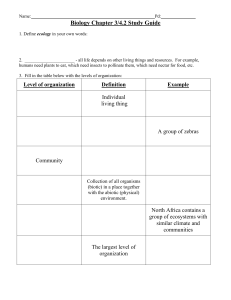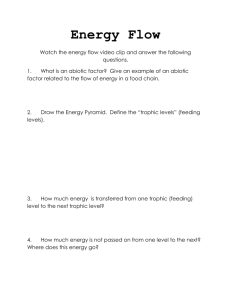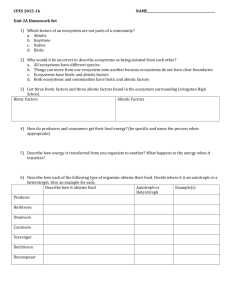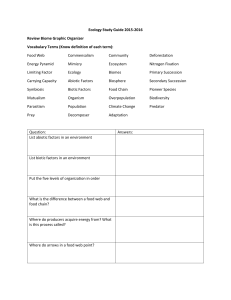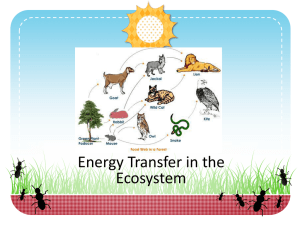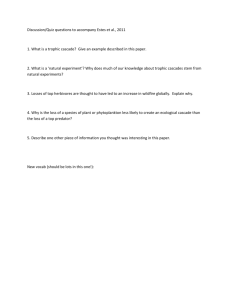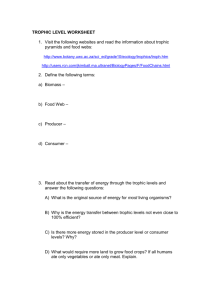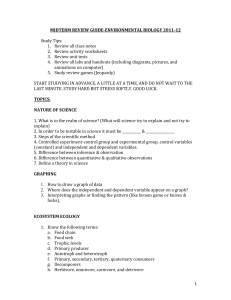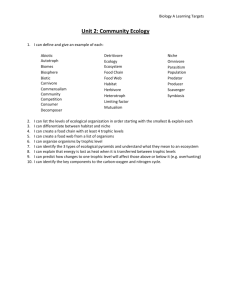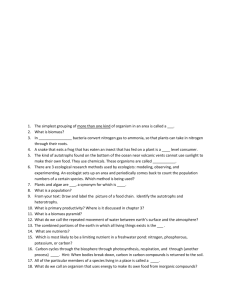Chapter 3 Notes
advertisement
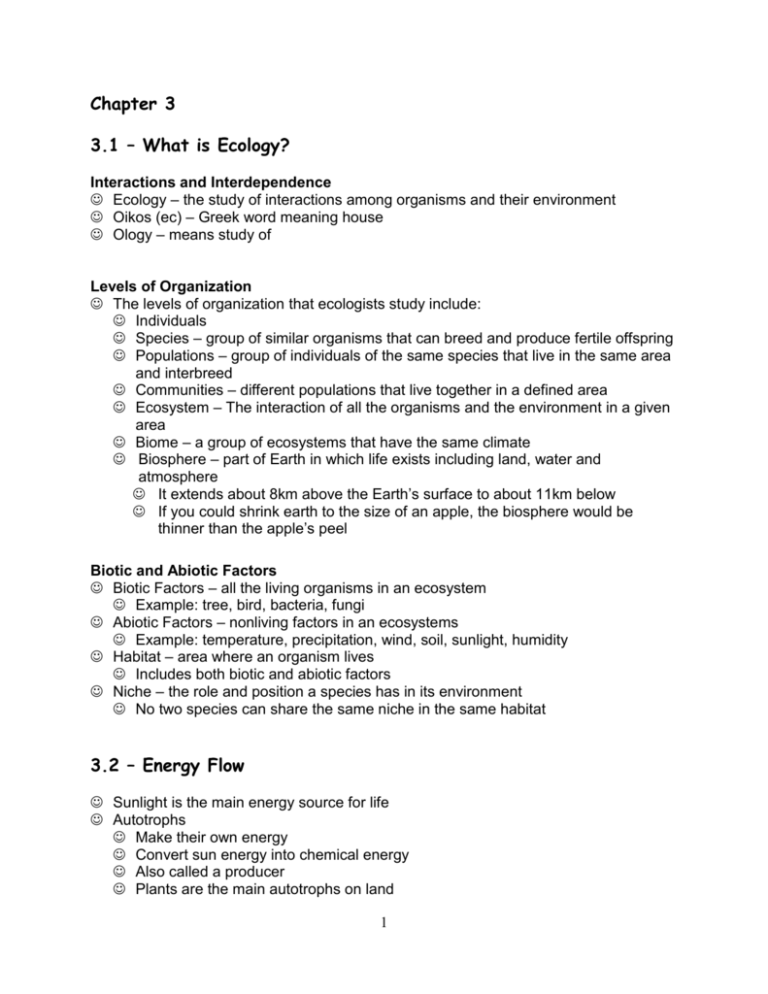
Chapter 3 3.1 – What is Ecology? Interactions and Interdependence Ecology – the study of interactions among organisms and their environment Oikos (ec) – Greek word meaning house Ology – means study of Levels of Organization The levels of organization that ecologists study include: Individuals Species – group of similar organisms that can breed and produce fertile offspring Populations – group of individuals of the same species that live in the same area and interbreed Communities – different populations that live together in a defined area Ecosystem – The interaction of all the organisms and the environment in a given area Biome – a group of ecosystems that have the same climate Biosphere – part of Earth in which life exists including land, water and atmosphere It extends about 8km above the Earth’s surface to about 11km below If you could shrink earth to the size of an apple, the biosphere would be thinner than the apple’s peel Biotic and Abiotic Factors Biotic Factors – all the living organisms in an ecosystem Example: tree, bird, bacteria, fungi Abiotic Factors – nonliving factors in an ecosystems Example: temperature, precipitation, wind, soil, sunlight, humidity Habitat – area where an organism lives Includes both biotic and abiotic factors Niche – the role and position a species has in its environment No two species can share the same niche in the same habitat 3.2 – Energy Flow Sunlight is the main energy source for life Autotrophs Make their own energy Convert sun energy into chemical energy Also called a producer Plants are the main autotrophs on land 1 Algae are the main autotrophs in water Some autotrophs can produce food in the absence of light Chemoautotrophs – organisms use chemical energy to produce carbohydrates Performed by several types of bacteria Live in… Volcanic vents Deep ocean Hot springs Marshes Heterotrophs Get energy from other organisms Unable to make its own energy Also called consumers Types of Heterotrophs Herbivores Eats only plants Example: cows, deer, rabbits, bees, elephants, squirrels Carnivores Eats only animals Example: snakes, dogs, lions, crocodiles Omnivores Eats plants and animals Example: humans, bears, crows Detrivores Eat decomposing bits of organic matter Example: mites, earthworms, snails, crabs Decomposers Break down organic matter Example: bacteria and fungi Scavenger Ingest nonliving plants and animals Example: vulture, termite, beetle Feeding Relationships Food Chain – a straight line series of steps by which energy is stored and passed on to higher trophic levels Food Web – a network of crossing interlinked food chains that shows all the possible feeding relationships at each trophic level Energy is passed through no more than four or five trophic levels Trophic Levels – step in a food chain or food wed Plants and other producers are 1st trophic level Consumers make up the 2nd, 3rd, or higher trophic levels Each consumer depends on the trophic level below it for energy 2 Energy is transferred from one trophic level to another and is never 100% At each trophic level only 10% of the energy taken in by the organism is stored. The rest is used up during metabolism to process the energy Community Interactions Competition – occurs when organisms of the same or different species attempt to use the same resources Predator – eat other animals Prey – the animal a predator eats Symbiosis – relationship in which two species live closely together Three Types of Symbiosis 1. Mutualism Both species benefit from the relationship Example: plants and bacteria on roots Shark and fish 2. Commensalism One organism benefits and the other is neither helped nor harmed Example: tree and bird nest 3. Parasitism One organism lives on or inside another organism and harms it Example: tick, ringworm Ecological Pyramids Ecological Pyramid – a diagram that shows the relative amounts of energy or matter contained within each trophic level in a food chain or food web Example: Ecological Pyramids 3 3-3 Cycles of Matter Biogeochemical Cycles – process in which elements, chemical, and other forms of matter are passed from one organism to another and from one part of the biosphere to another The Water Cycle Evaporation – process by which water changes from a liquid to a gas Transpiration – loss of water from plants by the process of evaporation Condensation – water vapor changes to a liquid Precipitation – water returns to the earth (rain, snow, hail) The Carbon Cycle Carbon is released into the atmosphere by… Respiration Burning fossil fuels Volcanic activity Burning trees Carbon is taken out of the atmosphere by… Photosynthesis performed by plants Carbon is released into the ground by… Decomposition of plants and animals Carbon is taken out of the ground by… Mining Roots of plants Nitrogen Cycle Gaseous nitrogen (N2)makes up 80% of the atmosphere Nitrogen Fixation Bacteria convert N2 to ammonia (NH3) This dissolves forming ammonium (NH4) Ammonification Bacteria degrade nitrogenous wastes and remains of organisms Convert NH3 to NH4+ Nitrification Bacteria convert NH4 to nitrite (NO2) to nitrate (NO3) Denitrification Bacteria convert nitrate or nitrite (NO3, NO2) to N2 N2 is released back into the atmosphere Humans are harming the nitrogen cycle by: Deforestation Conversion of grasslands for agriculture Sewage enters waterways Fossil fuel burning Vehicles having combustion engines releases NO2 4 4-2 What Shapes an Ecosystem? Ecological Succession Succession – changes that occurs in a community over time Pioneer Species – first species to populate the area Climax Community – a stable mature community that undergoes little or no change in species Two Types of Succession 1. Primary Succession Succession that occurs on surfaces where no soil exists Example: rock surfaces formed after volcanoes erupt 2. Secondary Succession Succession following a disturbance that destroys a community without destroying the soil Because soil already exists, secondary succession usually takes less time than primary succession Example: fires, floods, farming, construction, hurricanes, tornadoes 5 6 Gaseous Nitrogen N2 Nitrogen Fixation Ammonification Denitrification Bacteria in the soil convert N2 → NH3 → NH4 Bacteria convert wastes and decomposing organics to NH3 → NH4 Bacteria convert NO3 → N2 Autotrophs can take up NH4 and NO3 Nitrification Bacteria convert NH4 → NO2 → NO3 7 CO2 Organism eats plants C6H12O6 Decomposition Oil Coal 8 Chapter 3 3.1 – What is Ecology? Interactions and Interdependence Ecology – Oikos (ec) – Greek word meaning ____________ Ology – means __________ _____ Levels of Organization The levels of organization that ecologists study include: Individuals Species – Populations – Communities – Ecosystem – Biome – Biosphere – It extends about _____km above the Earth’s surface to about _____km below If you could shrink earth to the size of an apple, the biosphere would be thinner than the apple’s peel 9 Biotic and Abiotic Factors Biotic Factors – Example: Abiotic Factors – Example: Habitat – Includes both biotic and abiotic factors Niche – No two species can share the same niche in the same habitat 3.2 – Energy Flow _______________ is the main energy source for life Autotrophs Convert __________ energy into ____________ energy Also called a _______________ ____________ are the main autotrophs on land ____________ are the main autotrophs in water Some autotrophs can produce food in the absence of light Chemoautotrophs – Performed by several types of bacteria 10 Live in… Heterotrophs Also called _______________ Types of Heterotrophs Herbivores Example: Carnivores Example: Omnivores Example: 11 Detrivores Example: Decomposers Example: Scavenger Example: Feeding Relationships Food Chain – Food Web – 12 Energy is passed through no more than ________ or ________ trophic levels Trophic Level – _______________and other producers are 1st trophic level _______________make up the second, third, or higher trophic levels Each consumer depends on the trophic level below it for energy Energy is transferred from one trophic level to another and is never ________ At each trophic level only ________ of the energy taken in by the organism is stored. The rest is used up during _______________ to process the energy. Community Interactions Competition – Predator – Prey – Symbiosis – Three Types of Symbiosis 1. Mutualism Example: 2. Commensalism Example: 3. Parasitism Example: 13 Ecological Pyramids Ecological Pyramid – 3-3 Cycles of Matter Biogeochemical Cycles – The Water Cycle Evaporation – Transpiration – Condensation – Precipitation – 14 The Carbon Cycle Carbon is released into the atmosphere by … Carbon is taken out of the atmosphere by … Carbon is released into the ground by … Carbon is taken out the ground by … Nitrogen Cycle Gaseous nitrogen (N2) makes up ________% of the atmosphere Nitrogen Fixation This dissolves forming _______________ ________ Ammonification ____________ degrade nitrogenous wastes and remains of organisms Convert _______ to _______ Nitrification Bacteria convert ________ to ____________ (NO2) to ____________ (NO3) 15 Denitrification Bacteria convert ____________ or ____________ (NO2 and NO3) to N2 N2 is released back into the ______________ Humans are harming the nitrogen cycle by: Ecological Succession Succession – Pioneer Species – Climax Community – Two Types of Succession 1. Primary Succession Example: 2. Secondary Succession Succession following a disturbance that Because soil already exists, secondary succession usually takes ________ time than primary succession Example: 16
